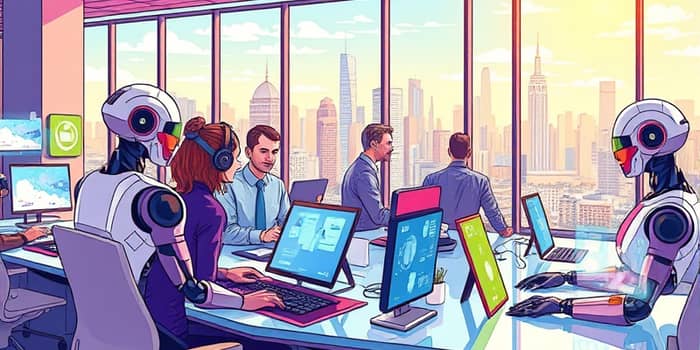As technology accelerates at an unprecedented pace, businesses and individuals alike face a pivotal moment. Automation and digital transformation promise extraordinary efficiency gains, but also bring challenges that require thoughtful navigation. This article explores the market dynamics, workforce impacts, sector-specific trends, and practical strategies to thrive in a rapidly evolving professional landscape.
Market Expansion and Growth Projections
The global landscape for industrial automation and digital workplaces is surging. The industrial automation market will reach $226.8 billion by 2025, reflecting a robust 10.8% CAGR through 2030. Similarly, the digital workplace market is set to grow to $58.93 billion in 2025, up from $49.17 billion in 2024.
Online collaboration tools are a major driver, with a market valuation of $13.5 billion in 2024. This rapid growth underlines the fundamental shift toward integrated, technology-enabled operations.
Productivity Gains and Automation ROI
Organizations adopting Robotic Process Automation (RPA) often see transformative results. Early adopters report 30–200% ROI in the first year, alongside average productivity increases of 25–30%. Error rates drop dramatically, by up to 75%, freeing teams to focus on higher-value tasks.
Generative AI tools further boost output, raising task throughput by 66%. When combined with intelligent automation platforms, these technologies redefine efficiency benchmarks across industries.
Workforce Impact: Challenges and Opportunities
Automation will reshape employment. By 2030, it is projected to displace 92 million jobs while creating 170 million new roles, yielding a net gain of 78 million positions globally. However, this transition intensifies the need for reskilling. Nearly 44% of workers will require new skills within five years.
Today, 75% of workers do not feel equipped for current digital demands, and 89% of companies foresee skill gaps. Addressing these gaps through continuous learning is essential to unlocking workforce potential.
Essential Skills for the Digital Age
- AI and big data analytics
- Cybersecurity and risk management
- Technological literacy and cloud proficiency
- Adaptability and digital collaboration
Organizations must cultivate these capabilities to remain competitive, while employees should proactively pursue targeted training programs.
Remote, Hybrid, and Digital Collaboration Models
Remote and hybrid work models have become mainstream. In 2025, 22.8% of U.S. employees will work remotely part-time, and hybrid roles will make up 24% of job postings. By 2028, 73% of teams will include remote members.
Strong digital workplace strategies correlate with 43% higher employee engagement and decision-making that is 31% faster. Yet remote work brings its own challenges: interruptions cost employees approximately 1.6 lost hours per month.
Sector-Specific Automation Transformations
This table illustrates how automation delivers tangible returns in diverse fields, from finance to manufacturing. Customizing solutions to sector-specific workflows maximizes value.
Overcoming Transformation Challenges
Despite the promise of digital transformation, 70% of projects fail to meet objectives and only 48% deliver expected outcomes. Major obstacles include the employee digital skills gap and inadequate change management practices.
To avoid pitfalls, leaders should:
- Engage employees early in the automation journey
- Invest in targeted upskilling programs
- Foster a culture of continuous learning
A Vision for the Digital Workforce
The future workforce will blend human ingenuity with digital labor. Roles such as AI trainers, data ethicists, and digital colleagues are emerging rapidly. By 2030, 82% of leaders expect digital labor to significantly expand organizational capacity.
Leaders must balance expanding capacity with digital labor and robust upskilling initiatives. Lifelong learning, supported by accessible training platforms, will be the cornerstone of sustainable growth.
Practical Strategies for Employees and Employers
For employees, the path forward involves:
- Assessing personal skill gaps and seeking relevant certifications
- Embracing cross-functional projects to gain diverse experiences
- Networking in digital communities to share insights
Employers can support this journey by offering mentorship programs, microlearning modules, and clear career roadmaps tied to new technology initiatives.
Conclusion: Embracing Change for Collective Success
Automation and digital transformation are not distant trends; they are reshaping work today. While challenges abound—from skill gaps to change resistance—the opportunities for innovation, productivity, and job creation are immense.
By fostering an inclusive culture of continuous learning and strategically integrating technologies, organizations and individuals can navigate this transition successfully. Together, we can build a future of work that is efficient, equitable, and inspiring.
References
- https://thunderbit.com/blog/automation-statistics-industry-data-insights
- https://www.myhubintranet.com/digital-transformation-statistics/
- https://kissflow.com/workflow/workflow-automation-statistics-trends/
- https://www.microsoft.com/en-us/worklab/work-trend-index/2025-the-year-the-frontier-firm-is-born
- https://www.nu.edu/blog/ai-job-statistics/
- https://sqmagazine.co.uk/digital-workplace-statistics/
- https://www.weforum.org/publications/the-future-of-jobs-report-2025/digest/
- https://remotedesk.com/blog/workforce-digital-transformation-key-strategies-trends-for-2025/
- https://www.shrm.org/executive-network/insights/research/employment-automated-era-october-2025-en-insights-forum
- https://www.secondtalent.com/resources/future-of-work-workplace-statistics/
- https://www.mckinsey.com/capabilities/tech-and-ai/our-insights/superagency-in-the-workplace-empowering-people-to-unlock-ais-full-potential-at-work
- https://www.deloitte.com/us/en/dbriefs-webcasts/2025-digital-workplace-trend-predictions.html
- https://www.pwc.com/gx/en/issues/workforce/hopes-and-fears.html
- https://www.sharefile.com/resource/blogs/workflow-automation-trend
- https://www.blueprism.com/resources/blog/future-automation-trends-predictions/










